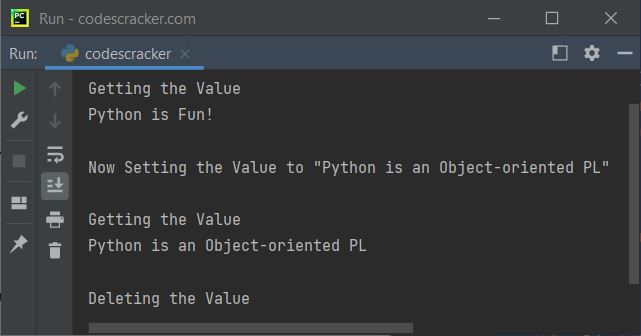- Python Basics
- Python Tutorial
- Python Applications
- Python Versions
- Python environment setup
- Python Basic Syntax
- Python end (end=)
- Python sep (sep=)
- Python Comments
- Python Identifiers
- Python Variables
- Python Operators
- Python Ternary Operator
- Python Operator Precedence
- Python Control and Decision
- Python Decision Making
- Python if elif else
- Python Loops
- Python for Loop
- Python while Loop
- Python break Statement
- Python continue Statement
- Python pass Statement
- Python break vs. continue
- Python pass vs. continue
- Python Built-in Types
- Python Data Types
- Python Lists
- Python Tuples
- Python Sets
- Python frozenset
- Python Dictionary
- List vs. Tuple vs. Dict vs. Set
- Python Numbers
- Python Strings
- Python bytes
- Python bytearray
- Python memoryview
- Python Misc Topics
- Python Functions
- Python Variable Scope
- Python Enumeration
- Python import Statement
- Python Modules
- Python operator Module
- Python os Module
- Python Date and Time
- Python Exception Handling
- Python File Handling
- Python Advanced
- Python Classes and Objects
- Python @classmethod Decorator
- Python @staticmethod Decorator
- Python Class vs. Static Method
- Python @property Decorator
- Python Keywords
- Python Keywords
- Python and
- Python or
- Python not
- Python True
- Python False
- Python None
- Python in
- Python is
- Python as
- Python with
- Python yield
- Python return
- Python del
- Python from
- Python lambda
- Python assert
- Python Built-in Functions
- Python All Built-in Functions
- Python print() Function
- Python input() Function
- Python int() Function
- Python len() Function
- Python range() Function
- Python str() Function
- Python ord() Function
- Python chr() Function
- Python read()
- Python write()
- Python open()
- Python Examples
- Python Examples
Python @property decorator
The @property is used to define new properties or modify existing ones. For example:
class CodesCracker: def __init__(self, val): self.v = val @property def val(self): print("\nGetting the Value") return self.v @val.setter def val(self, val): print("\nNow Setting the Value to \"", val, "\"", sep="") self.v = val @val.deleter def val(self): print("\nDeleting the Value") del self.v a = CodesCracker("Python is Fun!") print(a.val) a.val = "Python is an Object-oriented PL" print(a.val) del a.val
The sample output of the above program, demonstrating the @property decorator in Python, is shown in the snapshot given below:

The way to use the @property decorator, either to define new properties or to modify the existing ones, is:
class C(object): @property def x(self): return self._x @x.setter def x(self, value): self._x = value @x.deleter def x(self): del self._x
For example:
class CodesCracker: def __init__(self, stud): self.s = stud @property def stud(self): print("\nGetting the Name of Student...") return self.s @stud.setter def stud(self, nstud): print("\nNow Setting Name of Student to \"", nstud, "\"", sep="") self.s = nstud @stud.deleter def stud(self): print("\nDeleting the Name of Student...") del self.s x = CodesCracker("Emily Cale") print("The Name of Student is:", x.stud) x.stud = "Joey Lynn King" print("Now the Name of Student is:", x.stud) del x.stud
The snapshot given below shows, of course, the sample output of this program:

Advantages of the @property decorator in Python
- Encapsulation: @property enables developers to conceal the implementation details of a class while providing a straightforward interface for accessing properties. This promotes encapsulation, a fundamental principle of object-oriented programming that facilitates the organization and maintenance of code.
- @property can be used to create computed properties derived from other class attributes or methods. This is useful when calculating a value based on other attributes, such as converting Celsius to Fahrenheit.
- Using @property can simplify code by removing the requirement for explicit getter methods. This makes the code more readable and concise.
- @property prevents modification by making an attribute read-only. Thus, it prevents unintended modification of the attribute, thereby enhancing the safety of the code.
Disadvantages of the @property decorator in Python
- Since @property executes a method to calculate the property value, it can result in a performance overhead compared to direct attribute access. For heavily utilized classes, this performance overhead can become significant.
- The @property decorator can be confusing for Python beginners, particularly if they are unfamiliar with computed properties. This may result in bugs or subpar code.
- Issues with Compatibility: Some third-party libraries or tools may not function correctly with @property, particularly if they rely on direct attribute access. This may necessitate additional workarounds to resolve compatibility problems.
« Previous Tutorial Python Keywords »